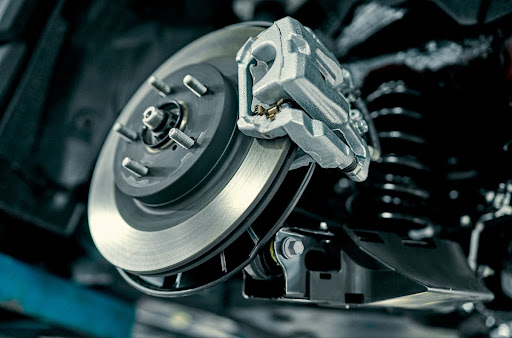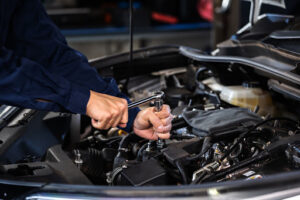The average car owner tends to put off repairs that aren’t immediately necessary. It’s understandable. Repairs are expensive. However, that’s a dangerous habit to get into.
Especially with your brakes.
Brakes last a long time, and they don’t suddenly go out. Unless a major malfunction occurs, of course. So, you might be tempted to drive on old brakes for a lot longer than you should.
That’s extremely dangerous, and you’re playing with fire. Here are 6 signs to look out for if you want to know when to replace brakes.
Let’s get into them!
1: Miles Driven
This is the most common reason you’ll need to get your brakes replaced. In an urban environment, 80,000 kilometers is the standard lifespan for brakes.
However, that number can be much higher if you’re a highway driver. Since you brake less on the highway, the brakes don’t wear down as quickly. It’s still not recommended to drive more than 100,000 kilometers on the same brakes.
This is because you grind off material every time you apply pressure to the brakes.
Usually, you only need to get a brake pad replacement when you use this milestone. If the other parts of the brake system need replacements, the other things we talk about will come into play.
2: Warning Light
Modern cars will tell you when it’s time to get your brakes worked on. At least, they will most of the time.
You can tell with a simple dash notification. If there’s a serious problem, you’ll see the word “BRAKE” illuminated on your dash.
This isn’t a surefire way to know that something is wrong, though. It also doesn’t tell you what is wrong.
A brake light can mean that the brakes don’t have enough pressure and are potentially leaking fluid or any number of other things. It also comes on when you use your parking brake. So, always make sure to check that before you start to worry.
If you see the brake light illuminated, check your parking brake. If it’s not engaged, do not drive the vehicle. Get it to a mechanic as soon as possible for brake repair or replacement. If there is a serious problem, your brakes might fail. That can create a life-threatening situation.
3: Car Favors One Side
This is an issue that commonly occurs when your tires aren’t in good shape. However, it can also mean that something is wrong with your brakes.
If one brake stops functioning properly, and the other does function as intended, your car will brake faster on one side. If one of the brakes doesn’t properly disengage from the rim on one side, your car can pull to one side while driving straight, too.
Usually, this just means a tire isn’t inflated properly or your tires aren’t aligned. So, you don’t have to worry about brake replacements immediately. You can check the tires first since wheel alignment is a more affordable option overall.
4: Visual Wear and Tear
If you’re not very good with cars, you won’t be able to notice this. At least, you won’t notice it until it’s really bad. However, if you are familiar with brakes to the slightest degree, you should be able to check them visually and see clearly when it’s time to replace brakes.
If you peek under your car, right behind the tire, you can see the brakes. If anything looks broken, you need help. If you notice that the pads are mostly worn away, you need to contact a mechanic for a pad replacement.
Even if you aren’t very good with cars, this is a skill you should learn. It’s part of a basic at-home vehicle inspection, and it should be part of your regular maintenance routine.
You’ll also save a lot of money learning to check your brakes visually. Instead of using standardized life expectancies, you can visually see how worn your brakes are.
This can help you stretch your brakes longer, and it will prevent you from needing a mechanic to perform a quick peak for something so simple.
5: Vibrations
Vibrations can happen with a vehicle for a massive number of reasons. It’s never a good thing, though. As such, you need to head to a mechanic any time you feel your car vibrating. The only time it shouldn’t be a major concern is if you’re on a bumpy gravel road or another surface that causes vibrations in the vehicle.
Since vibrations occur with engine problems, timing belts, brakes, and far more, it’s difficult to diagnose this as a brake issue immediately.
We can tell you why the brakes can cause vibrations, though.
As the more complicated parts of the braking system wear down, such as the rotors, the parts become out of alignment. They start to rub on each other while you drive. Metal parts start to bang, scratch, and everything else, and that causes the vibrations.
This is serious because those parts aren’t made to come into contact with one another. They’ll wear out very quickly. Within a few miles, you will likely hear a loud pop as part of your braking system goes flying.
Your immediate destination should be a mechanic or your garage.
There is one circumstance you can ignore this, though. As long as you know, it’s coming from the brakes. New brakes, or low-quality brakes, often vibrate while they brake in. Just be careful because a poor mechanic could also fail to align your brakes and cause the same issue.
6: Squealing
Squealing is a common sign that your brakes are having problems, but it’s not the worst.
Your brakes can squeal because they got wet. They can also just be brand-new and need to break in.
However, this can also be a problem with them overheating, or the caliper might be stuck.
If you just parked in tall, wet grass, or you have a low vehicle, and it just rained heavily, try to drive the car around the block. The squealing should stop.
In other situations, do a visual check, and contact a mechanic. If a caliper is stuck, continuing to drive can result in it breaking off and creating a dangerous situation.
Get Your Brakes Replaced at AML Auto
It’s not only imperative for you to know when to replace brakes but to have a trustworthy mechanic as well.
Many mechanics won’t tell you about these signs, but here at AML – we pride ourselves on our honesty and transparency.
If you need brake replacement anywhere in Toronto, give us a call, and we’ll make sure you’re safe on the road!


